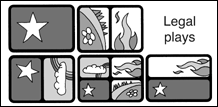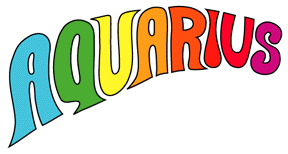

|
|
|
|
|
|
|
|
 Aquarius Rules in Spanish (PDF)
Aquarius Rules in Spanish (PDF)
The deck contains 5 Goal cards, 15 Action cards, and 40 Element cards.
Mix up the 5 Goal cards and deal one to each player. Don't let anyone else see your Goal card!
Shuffle the Action and Element cards and deal 3 cards to each player. Then deal out one more card, face up, in the center of the table. (If this card is an Action card, stick it in the middle of the deck and try again.)
The player with the longest hair goes first. Players take turns, drawing one card and playing one card. Element cards feature one, two, or four of the five elements (earth, fire, water, air, ether) and are placed face up in the center of the table. All players build on the same playing field. Action cards go in the discard pile after performing the action required. (If you can't make a legal play, then you must pass and play nothing.)
Each Element card must be played so that one of the elements on it matches up with a card already in play. Diagonal connections don't count. Cards cannot be placed skewed or perpendicular to one another.


When playing an Action card, place it face up in the discard pile next to the draw pile.
 |
Trade GoalsSwitch Goal cards with the player of your choice. |
 |
Shuffle GoalsGather up all of the Goal cards and deal a new one to each player. |
 |
Trade HandsSwap hands with the player of your choice. |
 |
Zap a cardSelect a card in play on the table, pick it up, and place it in your hand. |
 |
Move a cardSelect a card in play on the table and move it to a new legal location. |
Yes... when you zap a card, you will then have one more card in your hand.
Yes... when you move a card, you can put the card back in its original location but in a different orientation.
No... when trading hands, don't trade goals.
Also... when you shuffle goals, be sure to add in any unused goals if you are playing with less than five players.
The object of the game is to connect seven or more cards with the element shown on your Goal card. Diagonal connections do not count, each panel must be joined to another panel along a straight edge. Also, when counting connections, the size of the panel doesn't matter; a full size Earth panel is the same as a quarter size Earth panel.
If the deck runs out before someone wins, keep playing even though you don't get to draw new cards. Keep taking turns as long as someone has cards left; if there is no winner when all of the cards have been played, then the player whose number of connected elements is closest to seven is the winner.